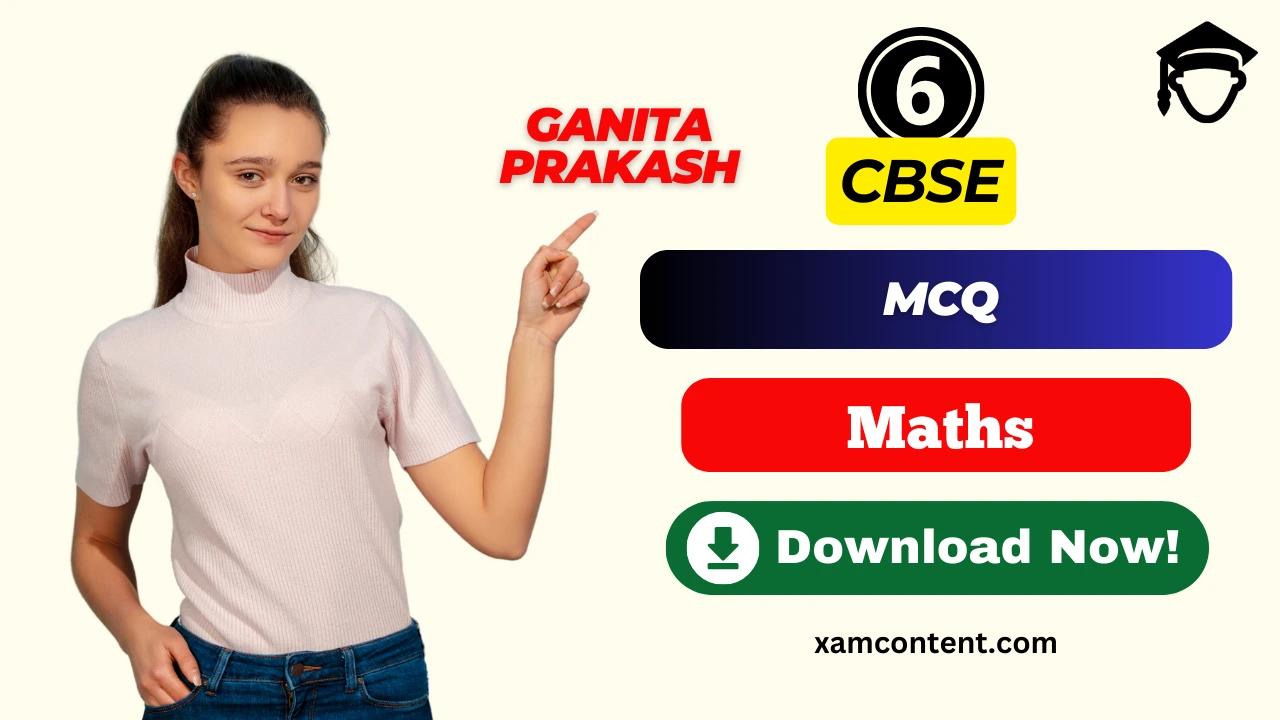Last Updated on November 4, 2025 by XAM CONTENT
Understanding the key concepts of Class 6 Maths Chapter 9 – Symmetry is crucial for exam success. To make your revision easier, we have created chapterwise mcq questions with Answers for class 6 Maths based on the latest syllabus and exam pattern. It is a part of MCQ Questions for CBSE Class 6 Maths Series.
These multiple-choice questions will help you assess your knowledge, improve accuracy, and boost confidence for your exams. Whether you are preparing for school tests, online tests or competitive exams, these Symmetry MCQs will strengthen your conceptual clarity.
| Chapter | Symmetry |
| Book | Ganita Prakash |
| Type of Questions | MCQ Questions |
| Nature of Questions | Competency Based Questions |
| Board | CBSE |
| Class | 6 |
| Subject | Maths |
| Useful for | Class 6 Studying Students |
| Answers provided | Yes |
| Difficulty level | Mentioned |
| Important Link | Class 6 Maths Chapterwise MCQ Questions |
MCQ Questions on Symmetry Class 6 Maths (PDF Download)
Q1. A figure that looks the same after folding along a line is said to have ________.
(a) rotation
(b) reflection
(c) line of symmetry
(d) translation
Show Answer
Ans: (c) line of symmetry.
Explanation: When one half of a figure covers the other exactly on folding, the dividing line is called its line of symmetry.
Q2. How many lines of symmetry does a square have?
(a) 2
(b) 3
(c) 4
(d) 6
Show Answer
Ans: (c) 4.
Explanation: A square can be folded along two diagonals, one vertical, and one horizontal line, making four lines of symmetry.
Q3. Which of the following shapes has only one line of symmetry?
(a) Circle
(b) Isosceles triangle
(c) Square
(d) Rectangle
Show Answer
Ans: (b) Isosceles triangle.
Explanation: Only an isosceles triangle can be folded into two identical halves along its altitude from the vertex.
Q4. A rectangle has how many lines of symmetry?
(a) 1
(b) 2
(c) 3
(d) 4
Show Answer
Ans: (b) 2.
Explanation: A rectangle has one vertical and one horizontal line of symmetry, but not along diagonals unless it is a square.
Q5. What is reflection symmetry also called?
(a) Rotational symmetry
(b) Mirror symmetry
(c) Translational symmetry
(d) Central symmetry
Show Answer
Ans: (b) Mirror symmetry.
Explanation: Reflection symmetry is also called mirror symmetry because one part of the figure is the mirror image of the other.
Q6. The line which divides a figure into two equal mirror halves is known as ________.
(a) diagonal
(b) radius
(c) axis of symmetry
(d) centre of rotation
Show Answer
Ans: (c) axis of symmetry.
Explanation: The line of symmetry is also called the axis of symmetry as it acts like an axis dividing equal halves.
Q7. Which of the following figures does NOT have any line of symmetry?
(a) Equilateral triangle
(b) Square
(c) Scalene triangle
(d) Circle
Show Answer
Ans: (c) Scalene triangle.
Explanation: In a scalene triangle, all sides and angles are different, so it cannot be divided into mirror halves.
Q8. The fixed point about which a figure is rotated is called the ________.
(a) centre of rotation
(b) axis of symmetry
(c) pivot of reflection
(d) centre of the figure
Show Answer
Ans: (a) centre of rotation.
Explanation: When a figure rotates about a fixed point, that point is called the centre of rotation.
Q9. When a figure is rotated by 90° and looks exactly the same, it is said to have ________.
(a) reflection symmetry
(b) translational symmetry
(c) rotational symmetry
(d) scaling symmetry
Show Answer
Ans: (c) rotational symmetry.
Explanation: Figures that look identical after being rotated through certain angles show rotational symmetry.
Q10. The angle through which a figure is rotated to coincide with itself is called ________.
(a) angle of rotation
(b) line of rotation
(c) angle of reflection
(d) turning line
Show Answer
Ans: (a) angle of rotation.
Explanation: The measure of the smallest turn that brings a figure back to its original position is called the angle of rotation.
Q11. A square has rotational symmetry of order ________.
(a) 1
(b) 2
(c) 3
(d) 4
Show Answer
Ans: (d) 4.
Explanation: A square coincides with itself four times in one full rotation (90°, 180°, 270°, 360°).
Q12. The smallest angle of rotational symmetry for an equilateral triangle is ________.
(a) 90°
(b) 120°
(c) 180°
(d) 60°
Show Answer
Ans: (b) 120°.
Explanation: An equilateral triangle coincides with itself after every 120° rotation.
Q13. Which figure has an infinite number of lines of symmetry?
(a) Square
(b) Circle
(c) Rectangle
(d) Triangle
Show Answer
Ans: (b) Circle.
Explanation: Every diameter of a circle divides it into two identical halves; hence it has infinite lines of symmetry.
Q14. A figure that has both reflection and rotational symmetry is ________.
(a) Parallelogram
(b) Circle
(c) Kite
(d) Scalene triangle
Show Answer
Ans: (b) Circle.
Explanation: A circle looks the same from every angle and along every diameter, showing both kinds of symmetry.
Q15. A figure looks identical after rotation by 180°. Its order of rotational symmetry is ________.
(a) 1
(b) 2
(c) 3
(d) 4
Show Answer
Ans: (b) 2.
Explanation: When a figure looks the same twice in one full rotation (180° and 360°), it has rotational symmetry of order 2.
Q16. What is the smallest angle of symmetry for a square?
(a) 45°
(b) 90°
(c) 180°
(d) 60°
Show Answer
Ans: (b) 90°.
Explanation: A square looks identical every 90° rotation, so 90° is its smallest angle of symmetry.
Q17. Which of the following figures has no rotational symmetry other than 360°?
(a) Rectangle
(b) Circle
(c) Scalene triangle
(d) Square
Show Answer
Ans: (c) Scalene triangle.
Explanation: A scalene triangle coincides with itself only after a complete turn (360°).
Q18. How many angles of rotational symmetry does a regular hexagon have?
(a) 3
(b) 4
(c) 5
(d) 6
Show Answer
Ans: (d) 6.
Explanation: A regular hexagon looks identical every 60° rotation (360° ÷ 6).
Q19. Every figure has one angle of symmetry equal to ________.
(a) 0°
(b) 90°
(c) 180°
(d) 360°
Show Answer
Ans: (d) 360°.
Explanation: Every figure coincides with itself after a full turn of 360°.
Q20. Which of these real-life objects shows symmetry?
(a) A leaf
(b) Human face
(c) Butterfly wings
(d) All of these
Show Answer
Ans: (d) All of these.
Explanation: Many natural objects like leaves, human faces, and butterfly wings show symmetry in shape and pattern.
We hope the given mcq questions with Answers for Symmetry Class 6 helps you in your learning.

Also check
- The Other Side of Zero – Class 6 Maths Chapter 10 MCQ Questions with Answers | Ganita Prakash Book
- Symmetry – Class 6 Maths Chapter 9 MCQ Questions with Answers | Ganita Prakash Book
- Playing with Constructions – Class 6 Maths Chapter 8 MCQ Questions with Answers | Ganita Prakash Book
- Fractions – Class 6 Maths Chapter 7 MCQ Questions with Answers | Ganita Prakash Book
- Perimeter and Area – Class 6 Maths Chapter 6 MCQ Questions with Answers | Ganita Prakash Book
- Prime Time – Class 6 Maths Chapter 5 MCQ Questions with Answers | Ganita Prakash Book
- Data Handling and Presentation – Class 6 Maths Chapter 4 MCQ Questions with Answers | Ganita Prakash Book
- Number Play – Class 6 Maths Chapter 3 MCQ Questions with Answers | Ganita Prakash Book
- Lines and Angles – Class 6 Maths Chapter 2 MCQ Questions with Answers | Ganita Prakash Book
- Patterns in Mathematics – Class 6 Maths Chapter 1 MCQ Questions with Answers | Ganita Prakash Book
Topics from which mcq questions may be asked
- Line of symmetry
- Mirror images
- Symmetrical patterns
Symmetry is all around us—in nature, art, and math.

You may also like

Frequently Asked Questions (FAQs) on Symmetry MCQ Questions
Q1: Why should I practice Class 6 Maths Chapter 9 MCQs?
A1: Practicing MCQs helps in quick revision, improves problem-solving speed, and enhances conceptual understanding of important topics in Class 6 Maths.
Q2: Are these Class 6 Maths MCQs based on the latest syllabus?
A2: Yes, all the MCQs are designed as per the latest CBSE syllabus and exam pattern to help students prepare effectively.
Q3: Where can I find more MCQs for Class 6 Maths?
A3: You can find more chapter-wise MCQs on our website. These are designed to cover important concepts and prepare you for exams.
Q4: Are the answers provided for all MCQs?
A4: Yes, each MCQ is accompanied by the correct answer and explanations to help students understand and learn better.
Q5: How can I improve my performance in Class 6 Maths MCQs?
A5: To improve your performance, practice regularly, revise key concepts, and take mock tests to assess your knowledge.
Q6: Do these MCQs help in school exams?
A6: Yes, these MCQs are aligned with school exam patterns and help in scoring well by strengthening conceptual clarity.
Q7: Can I download these MCQs for offline practice?
A7: Yes, you can download or print these MCQs for convenient offline practice.



